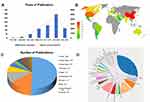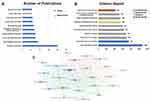Back to Journals » Journal of Pain Research » Volume 15
A Worldwide Bibliometric Analysis of Published Literature on Osteoporosis Vertebral Compression Fracture
Authors Li Y, Tian J, Ge M, Ji L, Kang Y, Xia C, Zhang J, Huang Y, Feng F , Zhao T, Shao H
Received 17 May 2022
Accepted for publication 5 August 2022
Published 18 August 2022 Volume 2022:15 Pages 2373—2392
DOI https://doi.org/10.2147/JPR.S375119
Checked for plagiarism Yes
Review by Single anonymous peer review
Peer reviewer comments 3
Editor who approved publication: Dr Alaa Abd-Elsayed
Yanlei Li,1,2,* Jinlong Tian,1,2,* Meng Ge,1,2,* Lichen Ji,1,3 Yao Kang,1 Chen Xia,1 Jun Zhang,1,2 Yazeng Huang,1,2 Fabo Feng,1 Tingxiao Zhao,1,2 Haiyu Shao1
1Center for Plastic & Reconstructive Surgery, Department of Orthopedics, Zhejiang Provincial People’s Hospital (Affiliated People’s Hospital, Hangzhou Medical College), Hangzhou, People’s Republic of China; 2Bengbu Medical College, Bengbu, People’s Republic of China; 3Wenzhou Medical University, Wenzhou, People’s Republic of China
*These authors contributed equally to this work
Correspondence: Haiyu Shao; Tingxiao Zhao, Center for Plastic & Reconstructive Surgery, Department of Orthopedics, Zhejiang Provincial People’s Hospital (Affiliated People’s Hospital, Hangzhou Medical College), Shangtang Road 158#, Hangzhou, 310014, People’s Republic of China, Email [email protected]; [email protected]
Background: With the aging population growth in the world, the prevalence of osteoporotic vertebral compression fracture (OVCF) is rapidly increasing and receiving widespread attention. Although there are numerous articles on the topic, the research status and hotspot analysis are unclear.
Objective: The goal of this study is to identify trends in the OVCF field and to analyze the most highly cited original articles published in the Web of Science Index on OVCF using bibliometric analysis.
Methods: All OVCF data were obtained from the Web of Science Core Collection, and the number of citations, institutions, journals, countries, and years of publication in this field were visually analyzed using VOSviewer, the bibliometrics online analysis platform, and Excel software. Simultaneously, the top 100 most cited articles were extracted and analyzed.
Results: A total of 756 publications were related to OVCF were included from 1900 to 2022. In recent years, the number of articles on OVCF significantly increased. They are mainly from 41 countries/regions and 202 journals, led by China and the United States. Among all countries, China had the most significant contribution on OVCF (n = 363), and it also was cited most often (n = 3337). The institution with the most articles was Soochow University (n = 40). Osteoporosis International was the journal with most studies and has published 50 on this field. The journal of Spine was cited most often (n = 1968). The most productive periods were from 2016 to 2020, which received 294 articles and 4868 citations. After the analysis, the “vertebroplasty” and “kyphoplasty” of OVCF have been the most common research hotspots.
Conclusion: This study represents an updated bibliometric analysis of OVCF. The aim is to identify current research hotspots and future trends to guide clinicians and researchers in this field.
Keywords: osteoporotic vertebral compression fracture, OVCF, bibliometric analysis, VOSviewer, Web of Science, research trends
Introduction
Osteoporosis, which is characterized by reduced bone mass and deterioration of bone architecture, has become a serious clinical problem in the elderly.1–3 At the same time, osteoporosis significantly increases the risk of brittle fracture, of which vertebral fracture is one of the most severe fracture types.4–6 The vertebral fractures secondary to osteoporosis are commonly regarded as osteoporotic vertebral compression fracture (OVCF), and spinal bone loss caused by osteoporosis and history of fall and fracture are considered to be the main risk factors.7,8 This type of fracture has become the third most common fragility fracture worldwide and the starting point of a lasting, severely painful, disabling condition and even death.2,9–12 Approximately 1.4 million of the elderly population regarding OVCF are diagnosed annually, and 16% of postmenopausal women worldwide suffering from it.10,13,14 The main clinical features of OVCF are described as the collapse/compression/wedging of a vertebral body and commonly showing lumbago and backache.10,15 Moreover, there are studies indicating that vertebral fracture caused by osteoporosis is associated with a decreased quality of life, as well as an increase in the disability rate and mortality.16,17 Therefore, the OVCF has seriously damaged human health and quality of life and brought heavy burden to family and society with the increase in social population aging.
Given the heightened attention in the OVCF, a large number of related articles have been published in academic journals in recent years. Nevertheless, the trend of OVCF research is unclear, and it is also a challenge to gain a comprehensive analysis of the research in OVCF. Bibliometric analysis has become a widely applied scientific research methodology due to its reliability and efficiency.18,19 Based on the quantitative analysis of published articles, it can measure the contribution of an individual, journal, institution or country by relevant parameters.20–22 This analysis can also roughly evaluate the trend of one specific topic and has been frequently conducted in various areas.23–25 Besides, another advantage of bibliometric analysis is the mining of valuable information and displaying it intuitively by the visualization.26 However, to our knowledge, no bibliometric studies on OVCF have been published to date. Therefore, the purpose of this bibliometric analysis is to identify the most influential publications, explore the research directions, analyze the research status and trends regarding OVCF, and provide related researchers with valuable information to facilitate collaboration.
Materials and Methods
Search Strategy
All the data of this study were obtained from articles retrieved from the core collection database of Web of Science on April 9, 2022. The following search strategy was used in this study: Title = (osteoporotic vertebral compression fracture) OR Title = OVCF AND Document type (article OR review) AND Language = English AND Time span = 1900 to 2022.
Tools
VOSviewer, the online bibliometric analysis platform (https://bibliometric.com), and Excel software were used to collect and analyze the data. VOSviewer and bibliometrics online analysis platform broadly recognized as the important tools were usually used to visually analyze the collaborative network of authors, institutions, countries and co-citation of keyword clusters to explore research trends and hotspots. The role of Excel software was used to identify various details of the publication, including title, author, journal, institution, country, year of publication, journal impact factors, citation reports and the number of published articles.
Data Extraction
According to the search strategy, the relevant parameters of articles were independently extracted by the two authors (YLL and TXZ), which discussed the vital information until they achieved a consensus. All data were obtained from the core collection database of Web of Science, and the useful information on OVCF was extracted and analyzed by using VOSviewer, online bibliometric analysis, and Excel software.
Result
Publication Trend
A total of 756 publications regarding OVCF were retrieved in the core collection database of Web of Science from 1900 to 2022. The number of annual publications showed a relatively stable growth trend between 1991 and 2022 in general (Figure 1A). According to the quantitative analysis of the chart, a growing trend was revealed in the past fever decades in global research on OVCF, from 6 articles from 1991 to 1995 to 294 articles from 2016 to 2020. In addition, the research results indicate that OVCF is getting more and more attention and predicting a continual growth in the future. Some articles published between 2016 and 2020 attracted extensive research interest and were cited frequently as the basis, thus producing an important impact in the field.
Country Distribution
These articles are from at least 41 different countries and regions. The global contribution of OVCF is visually analyzed and displayed by value in the world map (Figure 1B). The number of publications in diverse countries/regions was intuitively displayed (only the top 10 countries/regions) (Figure 1C). Among the top 10 countries, China published the largest number of publications (n = 363), which accounted for more than half of article counts, followed by the United States (n = 99), South Korea (n = 78). From Figure 1C, it can be seen that China has become the major contributor to OVCF research. Next, we analyzed the importance of countries in the collaboration network visualization by using online bibliometric analysis platform. The visual network map showed that China was the most active country far beyond the impact of any other countries/regions, followed by the United States, South Korea, Japan, Germany, and the Netherlands, which were potential power on OVCF research (Figure 1D). Furthermore, the cooperation between China and Canada as well as China and the United States occurred frequently.
Analysis of Institution
The research of the published papers covers at least 828 diverse professional agencies. In terms of research institutions, the top 10 were Soochow University (n = 40), Capital Medical University (n = 18), Xi An Jiao Tong University (n = 15), Nanjing Medical University (n = 15), Guangzhou University of Chinese Medicine (n = 14), Zhejiang University (n = 13), Chang Gung University (n = 13), Shandong University (n = 12), Leiden University (n = 11), and Sichuan University (n = 11) (Figure 2A). In addition, the other 9 of the top 10 most prolific organizations were from China, except Leiden University. According to the citation report, studies from Saint Elizabeth Hospital had the highest number of citations (n = 1080), and the next two high-citation agencies were Cleveland Clinic Foundation (n = 746) and University of Groningen (n = 698) (Figure 2B).
We by using VOSviewer software identified the network map of bibliometric coupling between institutions beyond seven publications. The result revealed the collaboration status of 24 institutions on the network map, which indicated the strength of the coupling relationship via the thickness of the lines, and represented the number of published articles by the size of the node (Figure 2C). In this visual analysis, Soochow University had the highest total link strength (n = 4178), followed by Capital Medical University (n = 3150), Guangzhou University of Chinese Medicine (n=2810), and Zhejiang University (n = 2799). Furthermore, the strongest coupling relationship between Soochow University and Nanjing Medical University indicated their direction of studies is more similar and have most of the same reference documents.
Journal of Publication
In the past few decades, a total of 212 academic journals appeared in the research field of OVCF. The result showed the top 10 most active journals for publishing articles on the research field of OVCF, most of which are located in the United States (Table 1). Among all the journals, Osteoporosis International (n = 50) had the most contribution, followed by Spine (n = 35), World Neurosurgery (n = 34), European Spine Journal (n = 32), Medicine (n = 28), Journal of Orthopaedic Surgery and Research (n = 27), Pain Physician (n = 26), Journal of Spinal Disorders & Techniques (n = 16), Spine Journal (n=14), and BMC Musculoskeletal Disorders (n = 14). Moreover, Spine and Osteoporosis International had the highest citation counts, which received 1968 and 802 citations, respectively.
 |
Table 1 Journals Publishing Most on Osteoporotic Vertebral Compression Fracture |
Analysis of Author
Using online bibliometric platform to analyze the contribution of authors, we identified the top 10 active authors in the field of OVCF research (Table 2). Among them, Yang, H.L. from Soochow University in China was on the top of the list, with 27 articles and counted 5 as first author, 11 as the corresponding author, and the next two high-production authors were Hao, D. J. (n = 13) from the Xi An Jiao Tong University in China and Zhang, L. from Beijing Hospital (n = 12).
 |
Table 2 Top 10 Prolific Authors on Osteoporotic Vertebral Compression Fracture |
Keyword Analysis and Research Hotspot
Keywords are the core of the research field of a paper. The accuracy and frequency of keywords are two important factors that affect the research focus of co-occurrence recognition. In the co-occurrence network analysis, a total of 1418 keywords were obtained in OVCF research by using VOSviewer software, and 90 keywords met the threshold that occurred at least 10 times (Figure 3A). The size of the node represents the number of the occurrences of terms in the literature (Author Keywords + Keywords Plus). The thickness of the connecting line indicates the link strength of two keywords. We used a visual approach to analyze the important keywords from the literature and classified into 3 clusters (diagnosis, treatment, and complications). As shown in Figure 3A, we can identify the clusters of red, green, and blue, which, respectively, represent three different research directions of OVCF. The main keywords of diagnosis cluster of red were “osteoporosis”, “vertebral compression fracture”, “spine”, “kyphoplasty” and “vertebroplasty”. While the keywords of treatment cluster of blue included “percutaneous vertebroplasty”, “balloon kyphoplasty”, “randomized trial”, “efficacy” and “augmentation”, and complications cluster of green mainly included “cement leakage”, “OVCF”, “leak”, “risk factors” “and meta analysis.”
According to the timeline viewer analysis of clustering, the colors represented the average year of publication of the identified keywords, as well as found the dynamic trend of research hotspot evolution in this field. In the early stage, “osteoporosis”, “vertebral compression fracture”, “spine”, “cement”, and “women” were the main research directions regarding OVCF (Figure 3B). Now the newest topics have turned into “osteoporotic vertebral compression fractures”, “risk factors”, “conservative treatment”, “percutaneous kyphoplasty”, and “meta analysis.” Through the analysis of the keywords, we can obtain research topics in a specific field, explore the research focus and the research direction.
Top 100 Cited Articles
During the study period, we identified the top 100 cited articles on OVCF in the core collection database of Web of Science (Table 3). These articles were published between 1993 and 2018. The period in which the most frequently cited articles were published was 2006 through 2010, received 40 articles and 3086 citations (Figure 4A).
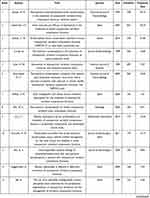 | 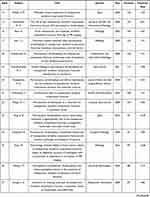 | 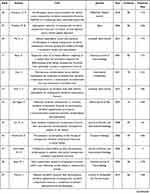 | 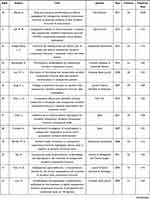 | 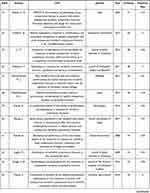 | 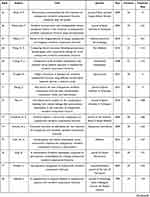 | 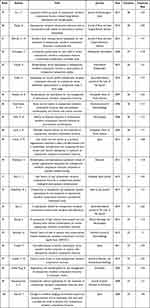 |
Table 3 Top 100 Most-Cited Articles on Osteoporotic Vertebral Compression Fracture |
The 100 most-cited publications were abstracted from 77 institutions. Among these articles, Saint Elisabeth Hospital from the Netherlands contributed 6 of the top 100 articles, and the Leiden University Medical Center, Soochow University and Tianjin Medical University each contributed 4 articles (Figure 4B). The analysis results have shown that the number of papers published by scientific institutions can roughly reflect their scientific research ability in related fields. Hence, the top 10 institutions, which account for 31% of total publications, have become the most representative institutions in this field of OVCF research.
The top 100 most cited articles cover a total of 19 countries/regions. According to the national article statistics, the largest contributor of article counts was China (n = 25), followed by the United States (n = 19), the Netherlands (n = 13), Germany (n = 8), South Korea (n = 7), Japan (n = 6), Canada, Sweden (n = 4) and France, Italy (n = 2) (Figure 4C). But the most cited articles were from the United States, with 2624 citations and 138.11 average citations. The countries of higher average citations were France (n = 196.5), the United States (n = 138.11) and the Netherlands (n = 113). Although China ranked first in terms of number of articles, the per citations of articles were lower.
There are 42 different journals which generated the top 100 articles. Among them, the Spine was the most prolific journal, with 13 articles and 1759 citations, followed by Journal of Spinal Disorders & Techniques (8 articles, 358 citations), American Journal of Neuroradiology (7 articles, 1284 citations), European Spine Journal (7 articles, 451 citations), Osteoporosis International (7 articles, 507 citations), Radiology (5 articles, 592 citations), Journal of Vascular and Interventional Radiology (4 articles, 313 citations) (Table 4). The top 7 journals of the 100 most cited articles on OVCF were mainly from the United States and the United Kingdom. It can be seen that have a strong scientific research strength and the high scientific research investment, especially in the United States.
 |
Table 4 Journals with More Than Three of the Top 100 Cited Articles on Osteoporotic Vertebral Compression Fracture |
In this research, the top 100 articles cover a wide range of topics in this field of OVCF. Among these articles, 35% of articles were related to clinical trial, which has become the world’s largest research direction on OVCF. The next three high-production fields were clinical description (n = 26%), surgical treatment (n = 15%) and basic research (n = 11%) (Figure 4D).
Discussion
Osteoporotic vertebral compression fracture (OVCF) is one of the most common causes of lumbago and backache, especially among the elderly, and generates a great challenge to researchers and clinicians.13,15,27,28 Most patients regarding OVCF, in addition to frequently suffering from consistent pain, have also been confirmed to have multiple adverse impacts such as impacting quality of life, physical function, mental health, and survival.13,29–33 Moreover, vertebral fracture is closely related to the increase in morbidity and mortality in the elderly.34,35 According to relevant studies, higher age and lower BMD are associated with fracture risk.36,37 BMD is also an important indicator for screening fracture risk and diagnosing osteoporosis. In fact, prior fracture history has the highest risk of osteoporotic fracture and is the strongest determinant of impending fracture risk.38 Other risk factors for OVCF include glucocorticoid use, family history of fracture, cigarette smoking, excessive alcohol intake, rheumatoid arthritis, low body weight, falls and frailty in elderly.38,39 In addition, studies have shown that bone-specific alkaline phosphatase is also associated with the risk of fracture and predicts fracture risk.40 For patients with osteoporosis, proper and timely use of anti-osteoporosis drugs can also be effective in reducing the risk of fracture, such as bisphosphonates and teriparatide.
Bibliometrics, first defined by Alan Pritchard in 1969, is an effective tool to quantitatively analyze the status and trends of a research field by using mathematics and statistical methods.41 It is also considered an important approach to compare the contributions of different countries, institutions, authors and journals in a certain field.42 Moreover, in addition to assessing trends in a particular study, it can also uncover valuable information hidden in the data and display it intuitively by the visualization.26 In recent years, with the growth in the number of publications and the development of visualization tools, bibliometric analysis has been widely used in biomedical sciences.43,44 Nevertheless, the trend of OVCF research is unclear, and it is also a challenge to gain a comprehensive analysis of the research in OVCF. Therefore, we achieved the visual analysis of research results through the VOSviewer, bibliometrics online analysis platform and Excel software. At the same time, this study will help related researchers with valuable information and guide the direction of future research.
Publication Trends in OVCF Research
The data analysis revealed a rapid growth trend on OVCF research in the last 20 years, especially from 2016 to 2020. The total publications of China ranked first of all the countries, suggesting that China made major contributions to the development of OVCF research. The cooperation among countries is growing closer, with between China and Canada, as well as China and the United States cooperating most frequently. With respect to institutional contributions, China was also the most active country and accounted for nine of the top 10 high-yield institutions. But in terms of total citations, Saint Elizabeth Hospital in the United States was the biggest contributor, with 1080 citations. At the same time, Institutions from the Netherlands should also pay special attention. The result indicated that the number of papers published by scientific research institutions can represent the research capacity in their field. Among these journals, the top 5 active journals on OVCF were Osteoporosis International from the United Kingdom, followed by journals from the United States, including Spine, World Neurosurgery, European Spine Journal and Medicine. Therefore, we can roughly infer publications from the United States and the United Kingdom were with relatively higher quality. Researchers studying OVCF should pay close attention to their dynamics and strengthen cooperation with these institutions and countries.
Research Interests
Keywords represent the core of the article and the research direction. In the co-occurrence analysis of keywords, the high-frequency keywords were “kyphoplasty”, “vertebroplasty”, “osteoporosis”, “balloon kyphoplasty”, and “percutaneous vertebroplasty”, and finally, three color clusters were formed on the basis of cluster analysis. To further explore the dynamic development of research hotspots, we evaluated the evolution of keywords over time. The analysis results indicate that the research direction has changed from clinical description to conservative treatment, complications and risk factor analysis. For example, the early common keywords are “injection”, “fracture”, “osteoporosis”, and “women”, while the newest keywords are mostly “conservative treatment”, “risk factors”, “zoledronic acid” and “recompression.” It can be seen that the research associated with “conservative treatment” and “risk factors” are the hot topics in recent years and have excellent developing trends in the future.
The Most Influential Articles
The number of citations can roughly reflect the quality and importance of the article. In this analysis, the most cited article on OVCF was the 1997 paper in the American Journal of Neuroradiology by Jensen et al, with 758 citations: “Percutaneous polymethylmethacrylate vertebroplasty in the treatment of osteoporotic vertebral body compression fractures: technical aspects”, which introduced the advantages of percutaneous vertebroplasty (PVP) for OVCF.45 The technique has been confirmed in 29 patients with 47 painful vertebral fractures. The main process includes percutaneous puncture of the involved vertebra and injection of polymethylmethacrylate (PMMA) into the related vertebral body. Furthermore, the surgical procedure and treatment experience of percutaneous vertebroplasty are described in detail in the article. At the same time, the technology provided that the easiest, safest, and efficient method was the fluoroscopically guiding transpedicular approach. Finally, the results show that the skill of percutaneous vertebroplasty (PVP) can relieve the pain of patients with OVCF and achieve early activities. To date, the PVP has become a classic surgery for the treatment of OVCF and attracted more and more attention. Although the PVP has been widely used in clinical practice to treat symptomatic OVCF, some recent studies have questioned its role in daily practice.46,47 According to randomized controlled trial analysis, the PVP was slightly different or no significant difference compared with placebo or sham procedure in terms of pain relief.47–49 At the same time, the bone cement distribution is related to postoperative complications, including bone cement leakage, kyphosis, adjacent segment fracture and loss of height.50–52
“Initial outcome and efficacy of kyphoplasty in the treatment of painful osteoporotic vertebral compression fractures” by Lieberman et al in 2001 was the second most influential article with 665 citations.29 The authors describe a new technique called kyphoplasty proposed by Dr. Mark Reiley that can restore the height of the collapsed vertebral body due to osteoporosis vertebral fracture. The new technology mainly includes two parts: inflatable bone tamps into the collapsed vertebral body and creating a cavity to fill bone cement. In this study, they evaluated the safety and effectiveness of kyphoplasty via 70 kyphoplasty procedures in 30 patients. It turns out that the kyphoplasty restored 47% of the lost height in 70% of the vertebral bodies and improvement of pain and function. Although vertebroplasty has been widely used to relieve the pain of VCF, about 30% of extravasation is still inevitable. Kyphoplasty is a valuable new tool in the treatment of osteoporotic vertebral compression fractures resulting in progressive kyphosis, effectively reducing the cement extravasation and the loss of vertebral height. Recent research, however, shows that kyphoplasty may increase the stresses and strains in the levels of adjacent vertebra and lead to new fractures.53–55
The third most cited article was published in the Lancet by Klazen et al from the Netherlands in 2010, which received 544 citations.14 Although the percutaneous vertebroplasty has been widely accepted, its efficacy, cost-effectiveness and safety are still questioned. In this study, they aimed at clarify whether percutaneous vertebroplasty has additional value compared with optimum conservative treatment in patients with acute osteoporotic vertebral fracture. A total of 431 patients were enrolled in the trial, of whom 202 patients with persistent pain were randomly assigned to treatment (101 vertebroplasty, 101 conservative treatments). Studies have shown that in patients with acute osteoporotic vertebral fractures with persistent severe pain, vertebroplasty can relieve pain faster and better than conservative treatment. In addition, vertebroplasty was more reliable for pain relief and cost-effectiveness than conservative treatment at 1-year follow-up. The authors’ study comprehensively compares vertebroplasty with the reference therapy, thus providing clinicians with directly applicable information for optimal treatment of patients.
Conventional conservative treatment is appropriate for patients with mild-to-moderate pain and without significant vertebral deformity, including bed rest, pain medication, physical therapy, bracing and anti-osteoporosis drugs.55,56 However, it is difficult to prevent the deterioration of fracture displacement, with the risk of nonunion, residual pain, malunion in kyphosis, decubitus ulcers and venous thromboembolism, especially elderly patients.57,58 Conversely, if the patient’s pain is severe and acute, PVP is effective and safe.59 However, there are no benefits to be found in patients with older fractures or fractures of no pain. For balloon kyphoplasty, it is more suitable for height deformity and has many advantages, such as a less injected cement volume, better short-term pain relief, a lower cement leakage rate and better improvement of kyphotic angle.58,60 However, vertebroplasty changes the strength of the fractured vertebral body, which increases the risk of fracture and degeneration of adjacent vertebral bodies.61,62 Neurological deficit, posterior wall involvement or severe vertebral collapse are contraindications to these minimally invasive techniques.57 If there is a neurological deficit, the surgical fusion techniques are appropriate. Vertebroplasty with posterior spinal fusion, which is a less invasive procedure, is characterized by low risk, shorter operation time, less blood loss and a lower perioperative complication rate.63,64 Therefore, it is widely used for OVCF patients with neurological deficits.65 Different schemes are applicable to different patients, so it is necessary to provide personalized schemes through full preoperative evaluation.
Limitations
Although bibliometric analysis can provide relatively comprehensive and objective information, it still has several limitations. First of all, only articles published in Web of Science Core Collection database-related OVCF were extracted into this research. It is possible that some high-quality articles are excluded because they are not included in this database. Secondly, due to the dynamic changes of data, the retrieval results of this study will be different from the actual inclusion. Finally, only English articles were obtained in this research, thus we may lose some articles in non-English languages on OVCF research.
Conclusion
Quantitative analysis showed that there is a growing trend in annual publications regarding OVCF research worldwide in the last 20 years. In this research, China is the most productive on OVCF research, Soochow University from China is the most productive institution, Yang, H. L. is the major contributor. Osteoporosis International, Spine, World Neurosurgery, European Spine Journal and Medicine are the top five most popular journals on this topic. Percutaneous vertebroplasty and kyphoplasty are the most influential research fields. “conservative treatment”, “risk factors”, and “zoledronic acid” are the latest research hotspots, which will have a good developing trend in the future.
Funding
This study was supported by grants from the Department of Health of Zhejiang Province (2020KY408 to Dr. Jun Zhang, 2022KY548 to Dr. Haiyu Shao, and 2022KY608 to Dr. Tingxiao Zhao), and the Natural Science Foundation of Zhejiang Province (LQ19H160014 to Dr. Fabo Feng and LGD22H060004 to Dr. Jun Zhang).
Disclosure
The authors report no conflicts of interest in this work.
References
1. Peck WA. Consensus development conference: diagnosis, prophylaxis, and treatment of osteoporosis. Am J Med. 1993;94(6):646–650. doi:10.1016/0002-9343(93)90218-e
2. Long Y, Yi W, Yang D, Jiang N. Advances in vertebral augmentation systems for osteoporotic vertebral compression fractures. Pain Res Manag. 2020;2020:3947368. doi:10.1155/2020/3947368
3. Kanis JA, Kanis JA. Assessment of fracture risk and its application to screening for postmenopausal osteoporosis: synopsis of a WHO report. WHO Study Group. Osteoporos Int. 1994;4(6):368–381. doi:10.1007/BF01622200
4. Kanis JA, Glüer CC. An update on the diagnosis and assessment of osteoporosis with densitometry. Committee of Scientific Advisors, International Osteoporosis Foundation. Osteoporos Int. 2000;11(3):192–202. doi:10.1007/s001980050281
5. Ensrud KE, Crandall CJ. Osteoporosis [published correction appears in Ann Intern Med. 2017 Oct 3;167(7):528]. Ann Intern Med. 2017;167(3):ITC17–ITC32. doi:10.7326/AITC201708010
6. Kim DH, Vaccaro AR. Osteoporotic compression fractures of the spine; current options and considerations for treatment. Spine J. 2006;6(5):479–487. doi:10.1016/j.spinee.2006.04.013
7. Hernlund E, Svedbom A, Ivergård M, et al. Osteoporosis in the European Union: medical management, epidemiology and economic burden. A report prepared in collaboration with the International Osteoporosis Foundation (IOF) and the European Federation of Pharmaceutical Industry Associations (EFPIA). Arch Osteoporos. 2013;8(1)):136. doi:10.1007/s11657-013-0136-1
8. Sambrook P, Cooper C. Osteoporosis [published correction appears in Lancet. 2006 Jul 1;368(9529):28]. Lancet. 2006;367(9527):2010–2018. doi:10.1016/S0140-6736(06)68891-0
9. Svensson HK, Olsson LE, Hansson T, Karlsson J, Hansson-Olofsson E. The effects of person-centered or other supportive interventions in older women with osteoporotic vertebral compression fractures – a systematic review of the literature. Osteoporos Int. 2017;28(9):2521–2540. doi:10.1007/s00198-017-4099-8
10. Johnell O, Kanis JA. An estimate of the worldwide prevalence and disability associated with osteoporotic fractures. Osteoporos Int. 2006;17(12):1726–1733. doi:10.1007/s00198-006-0172-4
11. Goldstein CL, Chutkan NB, Choma TJ, Orr RD. Management of the elderly with vertebral compression fractures. Neurosurgery. 2015;77(Suppl 4):S33–S45. doi:10.1227/NEU.0000000000000947
12. Ji C, Rong Y, Wang J, et al. Risk factors for refracture following primary osteoporotic vertebral compression fractures. Pain Physician. 2021;24(3):E335–E340.
13. Karmakar A, Acharya S, Biswas D, Sau A. Evaluation of percutaneous vertebroplasty for management of symptomatic osteoporotic compression fracture. J Clin Diagn Res. 2017;11(8):RC07–RC10. doi:10.7860/JCDR/2017/25886.10461
14. Klazen CA, Lohle PN, de Vries J, et al. Vertebroplasty versus conservative treatment in acute osteoporotic vertebral compression fractures (Vertos II): an open-label randomised trial. Lancet. 2010;376(9746):1085–1092. doi:10.1016/S0140-6736(10)60954-3
15. Manson NA, Phillips FM. Minimally invasive techniques for the treatment of osteoporotic vertebral fractures. J Bone Joint Surg Am. 2006;88(8):1862–1872. doi:10.2106/00004623-200608000-00026
16. Cooper C, Atkinson EJ, Jacobsen SJ, O’Fallon WM, Melton LJ. Population-based study of survival after osteoporotic fractures. Am J Epidemiol. 1993;137(9):1001–1005. doi:10.1093/oxfordjournals.aje.a116756
17. Roux C, Wyman A, Hooven FH, et al. Burden of non-Hip, non-vertebral fractures on quality of life in postmenopausal women: the Global Longitudinal study of Osteoporosis in Women (GLOW). Osteoporos Int. 2012;23(12):2863–2871. doi:10.1007/s00198-012-1935-8
18. Zhang Y, Zhao T, Wu T, et al. Bibliometric analysis of the scientific literature on rheumatoid arthritis-associated interstitial lung disease. Biomed Res Int. 2021;2021:7899929. doi:10.1155/2021/7899929
19. Koo M. Systemic lupus erythematosus research: a bibliometric analysis over a 50-year period. Int J Environ Res Public Health. 2021;18(13):7095. doi:10.3390/ijerph18137095
20. Khalil GM, Gotway Crawford CA. A bibliometric analysis of U.S.-based research on the behavioral risk factor surveillance system. Am J Prev Med. 2015;48(1):50–57. doi:10.1016/j.amepre.2014.08.021
21. Mahon NA, Joyce CW. A bibliometric analysis of the 50 most cited papers in cleft lip and palate. J Plast Surg Hand Surg. 2015;49(1):52–58. doi:10.3109/2000656X.2014.951053
22. Bornmann L, Leydesdorff L. Scientometrics in a changing research landscape: bibliometrics has become an integral part of research quality evaluation and has been changing the practice of research. EMBO Rep. 2014;15(12):1228–1232. doi:10.15252/embr.201439608
23. Ibrahim M, Jan SU. Bibliometric analysis of the Journal of Pakistan Medical Association form 2009 to 2013. J Pak Med Assoc. 2015;65(9):978–983.
24. Moodley J, Singh V, Kagina BM, Abdullahi L, Hussey GD. A bibliometric analysis of cancer research in South Africa: study protocol. BMJ Open. 2015;5(2):e006913. doi:10.1136/bmjopen-2014-006913
25. Rymer BC, Choa RM. A worldwide bibliometric analysis of published literature in plastic and reconstructive surgery. J Plast Reconstr Aesthet Surg. 2015;68(9):1304–1308. doi:10.1016/j.bjps.2015.05.024
26. Liao H, Tang M, Luo L, Li C, Chiclana F, Zeng X-J. A bibliometric analysis and visualization of medical big data research. Sustainability. 2018;10(1):166. doi:10.3390/su10010166
27. Jalava T, Sarna S, Pylkkänen L, et al. Association between vertebral fracture and increased mortality in osteoporotic patients. J Bone Miner Res. 2003;18(7):1254–1260. doi:10.1359/jbmr.2003.18.7.1254
28. Fujiwara S, Kasagi F, Masunari N, Naito K, Suzuki G, Fukunaga M. Fracture prediction from bone mineral density in Japanese men and women. J Bone Miner Res. 2003;18(8):1547–1553. doi:10.1359/jbmr.2003.18.8.1547
29. Lieberman IH, Dudeney S, Reinhardt MK, Bell G. Initial outcome and efficacy of “kyphoplasty” in the treatment of painful osteoporotic vertebral compression fractures. Spine. 2001;26(14):1631–1638. doi:10.1097/00007632-200107150-00026
30. Schlaich C, Minne HW, Bruckner T, et al. Reduced pulmonary function in patients with spinal osteoporotic fractures. Osteoporos Int. 1998;8(3):261–267. doi:10.1007/s001980050063
31. Beall DP, Olan WJ, Kakad P, Li Q, Hornberger J. Economic analysis of Kiva VCF treatment system compared to balloon kyphoplasty using randomized Kiva Safety and Effectiveness Trial (KAST) data. Pain Physician. 2015;18(3):E299–E306.
32. Silverman SL. The clinical consequences of vertebral compression fracture. Bone. 1992;13(Suppl 2):S27–S31. doi:10.1016/8756-3282(92)90193-z
33. Lombardi I, Oliveira LM, Mayer AF, Jardim JR, Natour J. Evaluation of pulmonary function and quality of life in women with osteoporosis. Osteoporos Int. 2005;16(10):1247–1253. doi:10.1007/s00198-005-1834-3
34. Srivastava M, Deal C. Osteoporosis in elderly: prevention and treatment. Clin Geriatr Med. 2002;18(3):529–555. doi:10.1016/s0749-0690(02)00022-8
35. Johnston CB, Dagar M. Osteoporosis in older adults. Med Clin North Am. 2020;104(5):873–884. doi:10.1016/j.mcna.2020.06.004
36. Banefelt J, Åkesson KE, Spångéus A, et al. Risk of imminent fracture following a previous fracture in a Swedish database study. Osteoporos Int. 2019;30(3):601–609. doi:10.1007/s00198-019-04852-8
37. Siris ES, Brenneman SK, Barrett-Connor E, et al. The effect of age and bone mineral density on the absolute, excess, and relative risk of fracture in postmenopausal women aged 50–99: results from the National Osteoporosis Risk Assessment (NORA). Osteoporos Int. 2006;17(4):565–574. doi:10.1007/s00198-005-0027-4
38. Legrand MA, Chapurlat R. Imminent fracture risk. Joint Bone Spine. 2021;88(3):105105. doi:10.1016/j.jbspin.2020.105105
39. Kanis JA, Borgstrom F, De Laet C, et al. Assessment of fracture risk. Osteoporos Int. 2005;16(6):581–589. doi:10.1007/s00198-004-1780-5
40. Ross PD, Kress BC, Parson RE, Wasnich RD, Armour KA, Mizrahi IA. Serum bone alkaline phosphatase and calcaneus bone density predict fractures: a prospective study. Osteoporos Int. 2000;11(1):76–82. doi:10.1007/s001980050009
41. Pritchard A. Statistical bibliography or bibliometrics? J Doc. 1969;25(4):348–349.
42. Laengle S, Merigó JM, Modak NM, et al. Bibliometrics in operations research and management science: a university analysis. Ann Oper Res. 2020;294(1):769–813. doi:10.1007/s10479-018-3017-6
43. van Eck NJ, Waltman L. Software survey: VOSviewer, a computer program for bibliometric mapping. Scientometrics. 2010;84(2):523–538. doi:10.1007/s11192-009-0146-3
44. Synnestvedt MB, Chen C, Holmes JH. CiteSpace II: visualization and knowledge discovery in bibliographic databases. AMIA Annu Symp Proc. 2005;2005:724–728.
45. Jensen ME, Evans AJ, Mathis JM, Kallmes DF, Cloft HJ, Dion JE. Percutaneous polymethylmethacrylate vertebroplasty in the treatment of osteoporotic vertebral body compression fractures: technical aspects. AJNR Am J Neuroradiol. 1997;18(10):1897–1904.
46. Buchbinder R, Johnston RV, Rischin KJ, et al. Percutaneous vertebroplasty for osteoporotic vertebral compression fracture. Cochrane Database Syst Rev. 2018;4(4)):CD006349. doi:10.1002/14651858.CD006349.pub3
47. Láinez Ramos-Bossini AJ, López Zúñiga D, Ruiz santiago F. Percutaneous vertebroplasty versus conservative treatment and placebo in osteoporotic vertebral fractures: meta-analysis and critical review of the literature. Eur Radiol. 2021;31(11):8542–8553. doi:10.1007/s00330-021-08018-1
48. Ebeling PR, Akesson K, Bauer DC, et al. The efficacy and safety of vertebral augmentation: a second ASBMR task force report. J Bone Miner Res. 2019;34(1):3–21. doi:10.1002/jbmr.3653
49. Firanescu CE, de Vries J, Lodder P, et al. Vertebroplasty versus sham procedure for painful acute osteoporotic vertebral compression fractures (VERTOS IV): randomised sham controlled clinical trial [published correction appears in BMJ. 2018 Jul 4;362:k2937. Smeet AJ [corrected to Smeets AJ]]. BMJ. 2018;361:k1551. doi:10.1136/bmj.k1551
50. He S, Zhang Y, Lv N, et al. The effect of bone cement distribution on clinical efficacy after percutaneous kyphoplasty for osteoporotic vertebral compression fractures. Medicine. 2019;98(50):e18217. doi:10.1097/MD.0000000000018217
51. Chen B, Li Y, Xie D, Yang X, Zheng Z. Comparison of unipedicular and bipedicular kyphoplasty on the stiffness and biomechanical balance of compression fractured vertebrae. Eur Spine J. 2011;20(8):1272–1280. doi:10.1007/s00586-011-1744-3
52. Lin J, Qian L, Jiang C, Chen X, Feng F, Lao L. Bone cement distribution is a potential predictor to the reconstructive effects of unilateral percutaneous kyphoplasty in OVCFs: a retrospective study. J Orthop Surg Res. 2018;13(1):140. doi:10.1186/s13018-018-0839-5
53. Ko BS, Cho KJ, Park JW. Early adjacent vertebral fractures after balloon kyphoplasty for osteoporotic vertebral compression fractures. Asian Spine J. 2019;13(2):210–215. doi:10.31616/asj.2018.0224
54. Li YX, Guo DQ, Zhang SC, et al. Risk factor analysis for re-collapse of cemented vertebrae after percutaneous vertebroplasty (PVP) or percutaneous kyphoplasty (PKP). Int Orthop. 2018;42(9):2131–2139. doi:10.1007/s00264-018-3838-6
55. Yi X, Lu H, Tian F, et al. Recompression in new levels after percutaneous vertebroplasty and kyphoplasty compared with conservative treatment. Arch Orthop Trauma Surg. 2014;134(1):21–30. doi:10.1007/s00402-013-1886-3
56. Lange A, Kasperk C, Alvares L, Sauermann S, Braun S. Survival and cost comparison of kyphoplasty and percutaneous vertebroplasty using German claims data. Spine. 2014;39(4):318–326. doi:10.1097/BRS.0000000000000135
57. Prost S, Pesenti S, Fuentes S, Tropiano P, Blondel B. Treatment of osteoporotic vertebral fractures. Orthop Traumatol Surg Res. 2021;107(1S):102779. doi:10.1016/j.otsr.2020.102779
58. Chang W, Zhang X, Jiao N, et al. Unilateral versus bilateral percutaneous kyphoplasty for osteoporotic vertebral compression fractures: a meta-analysis. Medicine. 2017;96(17):e6738. doi:10.1097/MD.0000000000006738
59. Lou S, Shi X, Zhang X, Lyu H, Li Z, Wang Y. Percutaneous vertebroplasty versus non-operative treatment for osteoporotic vertebral compression fractures: a meta-analysis of randomized controlled trials. Osteoporos Int. 2019;30(12):2369–2380. doi:10.1007/s00198-019-05101-8
60. Wang H, Sribastav SS, Ye F, et al. Comparison of percutaneous vertebroplasty and balloon kyphoplasty for the treatment of single level vertebral compression fractures: a meta-analysis of the literature. Pain Physician. 2015;18(3):209–222.
61. Kim YY, Rhyu KW. Recompression of vertebral body after balloon kyphoplasty for osteoporotic vertebral compression fracture. Eur Spine J. 2010;19(11):1907–1912. doi:10.1007/s00586-010-1479-6
62. Chang JZ, Bei MJ, Shu DP, Sun CJ, Chen JB, Xiao YP. Comparison of the clinical outcomes of percutaneous vertebroplasty vs kyphoplasty for the treatment of osteoporotic Kümmell’s disease: a prospective cohort study. BMC Musculoskelet Disord. 2020;21(1):238. doi:10.1186/s12891-020-03271-9
63. Katsumi K, Hirano T, Watanabe K, et al. Surgical treatment for osteoporotic thoracolumbar vertebral collapse using vertebroplasty with posterior spinal fusion: a prospective multicenter study. Int Orthop. 2016;40(11):2309–2315. doi:10.1007/s00264-016-3222-3
64. Uchida K, Nakajima H, Yayama T, et al. Vertebroplasty-augmented short-segment posterior fixation of osteoporotic vertebral collapse with neurological deficit in the thoracolumbar spine: comparisons with posterior surgery without vertebroplasty and anterior surgery. J Neurosurg Spine. 2010;13(5):612–621. doi:10.3171/2010.5.SPINE09813
65. Watanabe K, Katsumi K, Ohashi M, et al. Surgical outcomes of spinal fusion for osteoporotic vertebral fracture in the thoracolumbar spine: comprehensive evaluations of 5 typical surgical fusion techniques. J Orthop Sci. 2019;24(6):1020–1026. doi:10.1016/j.jos.2019.07.018
 © 2022 The Author(s). This work is published and licensed by Dove Medical Press Limited. The full terms of this license are available at https://www.dovepress.com/terms.php and incorporate the Creative Commons Attribution - Non Commercial (unported, v3.0) License.
By accessing the work you hereby accept the Terms. Non-commercial uses of the work are permitted without any further permission from Dove Medical Press Limited, provided the work is properly attributed. For permission for commercial use of this work, please see paragraphs 4.2 and 5 of our Terms.
© 2022 The Author(s). This work is published and licensed by Dove Medical Press Limited. The full terms of this license are available at https://www.dovepress.com/terms.php and incorporate the Creative Commons Attribution - Non Commercial (unported, v3.0) License.
By accessing the work you hereby accept the Terms. Non-commercial uses of the work are permitted without any further permission from Dove Medical Press Limited, provided the work is properly attributed. For permission for commercial use of this work, please see paragraphs 4.2 and 5 of our Terms.

